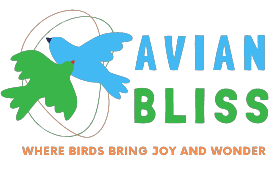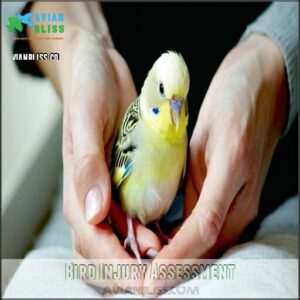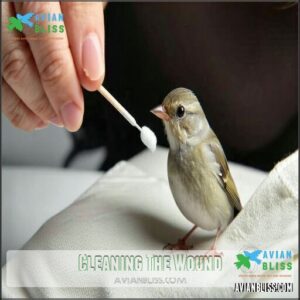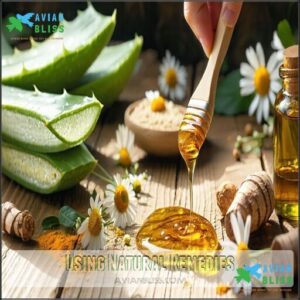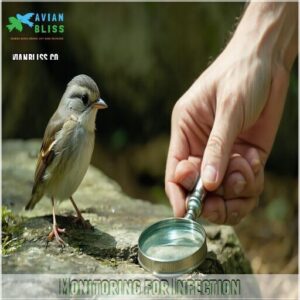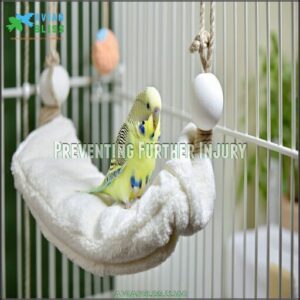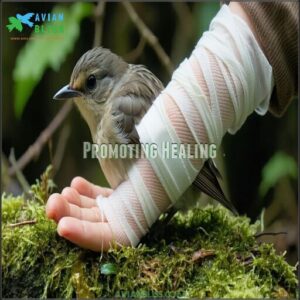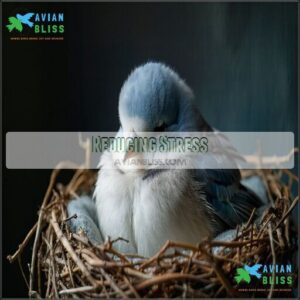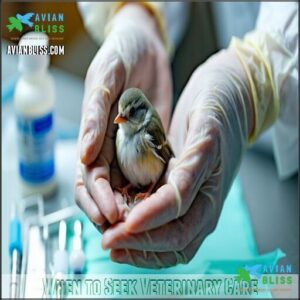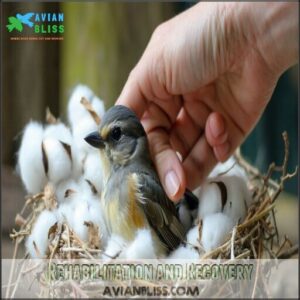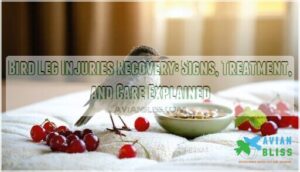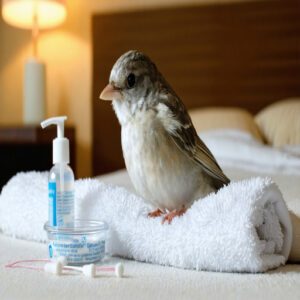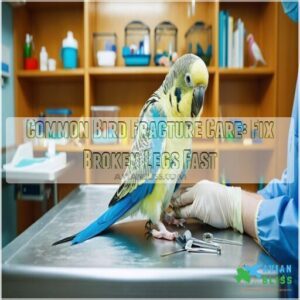This site is supported by our readers. We may earn a commission, at no cost to you, if you purchase through links.
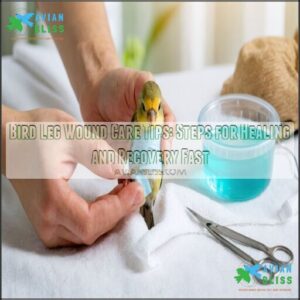
You’ll want to apply a thin layer of bird-safe antibiotic ointment and wrap the area with self-adhesive bandage—not too tight, birds have delicate bones.
Keep your feathered patient in a quiet, warm space with limited movement.
Change dressings daily and watch for redness or swelling.
Remember, a bird on the mend is like any patient—stress-free healing is key, and knowing proper bird leg wound care tips makes all the difference between recovery and complications, even for experienced bird handlers.
Table Of Contents
- Key Takeaways
- Bird Injury Assessment
- Treating Bird Leg Wounds
- Bird Leg Injury Care Tips
- When to Seek Veterinary Care
- Rehabilitation and Recovery
- Frequently Asked Questions (FAQs)
- What can I put on a bird’s open wound?
- How do you take care of a bird with a broken leg?
- How do you treat a cut on a bird?
- How long can a bird’s wound heal on its own?
- How to make DIY bird leg splints?
- Can birds take pain medication safely?
- What bedding works best for healing birds?
- How often should I change wound dressings?
- When can birds resume normal perching activities?
- Conclusion
Key Takeaways
- Clean the wound gently with diluted saline and apply a bird-safe antibiotic ointment before loosely wrapping it with a self-adhesive bandage.
- Keep the bird in a quiet, dimly lit environment with limited movement to reduce stress and promote healing.
- Watch daily for signs of infection like redness, swelling, or discharge, and change dressings promptly to maintain cleanliness.
- Seek vet care immediately for severe injuries like fractures, uncontrollable bleeding, or breathing difficulties.
Bird Injury Assessment
When your bird gets hurt, the first step is figuring out what’s wrong without stressing it out further.
A calm environment and a gentle hand can make all the difference during your quick but careful assessment.
Create a Calm Environment
A calm environment is key when treating injured birds.
Stress reduction helps healing, so focus on creating a quiet, dimly lit space.
Gently handling matters—avoid quick movements.
- Turn off loud devices for a peaceful vibe.
- Lower lighting to soothe the bird.
- Speak softly to reassure.
- Use soft towels for handling.
- Keep the bird securely contained.
Use Gentle Restraint
Once the bird feels safer in its calm environment, gently use the Towel Technique.
Wrap the bird loosely in a soft towel, leaving its injured leg free. Maintain a secure grip, but don’t squeeze—think holding a delicate snowflake.
Soft restraint methods reduce stress, helping with bird stress reduction and injury prevention.
Always prioritize calm movements to prevent further harm.
Start The Examination
Once you’ve secured Gentle Restraint, start by looking over the bird calmly.
Check for swelling, cuts, or visible issues near the injured leg. Use soft hands and keep the exam quick to Minimize Stress.
Gently assess the Condition, but don’t forget—birds can mask pain well. Understanding behavioral changes is also essential for identifying hidden injuries.
Treating bird wounds early helps avoid complications like a bird leg infection, which is crucial for a successful recovery and to prevent further complications.
Observe Movement
Take a good look at how the bird moves—it can reveal a lot about its leg injury.
Watch for gait abnormalities, perch grip struggles, or balance issues.
- Gait abnormalities: Limping or uneven movement can signal injury.
- Perch grip issues: Weak grip may indicate pain.
- Flight patterns: Struggling to fly hints at coordination problems.
- Balance struggles: Wobbling shows possible leg trouble.
Treating Bird Leg Wounds
Caring for a bird’s leg wound might seem tricky, but it’s manageable with the right steps.
Keeping the wound clean and infection-free is key to helping your feathered friend heal quickly.
Cleaning The Wound
Once you’ve spotted the injury, focus on bird wound cleaning gently.
Use sterile saline or other bird antiseptic wound solutions—avoid antiseptic solutions like alcohol. Always check dilution ratios for safe products.
Povidone iodine is a recommended antiseptic.
Clean the wound thoroughly, but don’t soak it. Pat dry—the wound drying process helps prevent infection.
Stick to a proper cleaning frequency to keep things under control.
Applying Antibiotic Ointment
Applying antibiotic ointment is key to bird wound care. Use bird-safe antibiotic ointment sparingly to avoid feather contamination.
Follow these steps:
- Gently clean the wound with bird wound antiseptic.
- Apply a thin layer of antibiotic ointment.
- Avoid overuse—less is more!
- Reapply every 24 hours for proper bird wound treatment.
- Watch for side effects like redness or irritation.
Consider using specialized antiseptic products for birds to ensure the best wound care and minimize the risk of infection.
Using Natural Remedies
Why not try natural remedies for bird wound care? Raw honey works wonders with its antimicrobial kick, while pure aloe vera soothes and speeds healing.
Use safe dilution for herbal antiseptics like chamomile or turmeric. Always check plant extracts’ safety first!
Remember, consult a vet if unsure—natural help is great, but it’s not a stand-in for expert advice, and always prioritize expert advice.
Monitoring for Infection
Watch for bird wound infection signs like redness, swelling, discharge, odor, or heat—think of these as your red flags.
If you notice any, it’s time to act fast.
Clean the wound gently and stick to infection prevention steps.
Monitor healing signs daily—healthy wounds improve, not stink.
Remember, infections are sneaky; catching them early saves headaches (and feathers)!
Bird Leg Injury Care Tips
Caring for a bird’s injured leg might sound tricky, but with the right steps, you can make a big difference in its recovery.
By creating a safe space, reducing stress, and encouraging healing, you’re giving your feathered friend a much-needed boost.
Providing a Safe Environment
Set up a birdsafe environment by focusing on cage safety.
Remove hazards like sharp edges, damaged toys, and unsafe plants. Use soft bedding and bird-friendly perches for comfort.
Regular inspections guarantee a bird-friendly environment stays that way. Consider purchasing a bird safe cage to guarantee your bird’s well-being.
Secure windows to avoid escape risks. During supervised playtime, keep an eye out for potential dangers—curiosity often leads birds into trouble!
Preventing Further Injury
After creating a safe environment, focus on preventing further bird leg injuries.
Here’s how:
- Remove cage hazards like broken toys or sharp objects.
- Always supervise playtime to catch risks early.
- Secure the environment by minimizing pesticides and covering windows.
- Use safe perches to support healing.
- Handle bird first aid carefully, limiting movement to avoid worsening the wound, which requires a gentle approach to prevent further injuries.
Promoting Healing
Helping a bird heal quickly means focusing on proper bird wound care. Gently clean wounds with a saltwater solution and keep the area moist using hydrocolloid dressings. Regularly check bandages—birds hate surprises, so stay consistent!
Understanding behavioral changes can also help identify hidden injuries. Here’s a quick guide:
| Tip | Why It Matters |
|---|---|
| Dietary Support | Boosts immune strength. |
| Cage Environment | Prevents reinjury. |
| Infection Control | Stops complications early. |
Reducing Stress
How do you keep an injured bird calm? Stress slows healing, so focus on creating comfort.
- Use a quiet environment to ease anxiety.
- Handle birds gently with calm handling and gentle restraint.
- Place them in a padded container for safety.
- Apply heating methods like warm towels for bird comfort.
- Practice calming techniques, like speaking softly during bird wound care.
When to Seek Veterinary Care
You’ll know it’s time to call the vet when things feel beyond your control, like serious bleeding or a leg bending in strange ways.
If your bird looks dazed, has trouble breathing, or just doesn’t seem “right,” don’t wait—professionals can make all the difference, as they are crucial in such emergency situations.
Profuse Bleeding
If you notice bird leg bleeding that won’t stop, act fast.
Apply immediate pressure with a clean cloth to slow the flow. Use styptic powder for blood clotting, but skip the tourniquet—it’s risky.
When controlling bleeding doesn’t work, seek veterinary intervention right away.
If the bleeding is under the wing, check for blood feathers as a potential cause.
Timely emergency response can save a bird’s life, so don’t hesitate to ask for professional help!
Severe Fractures
If there’s a bird leg fracture that looks severe, it’s time to act fast.
Fracture stabilization is your first priority. Avoid handling the leg further.
Complex splinting or surgical options might be necessary for bone regeneration.
Veterinary care guarantees the best long-term prognosis. A bird broken leg isn’t something you can fully fix at home, so don’t delay expert help for veterinary care.
Loss of Consciousness
Loss of consciousness in birds is a serious symptom that needs immediate veterinary care.
It can happen due to bleeding, head trauma, or shock.
Act quickly—place the bird in a padded, ventilated box to prevent further injuries.
Veterinary intervention might involve CPR techniques or stabilizing the bird.
The prognosis depends on the cause, so don’t delay, as time is critical!
Breathing Difficulties
Breathing troubles in birds, like panting, open-mouth breathing, or tail bobbing, demand attention fast.
Watch for nostril discharge or bluish skin (cyanosis)—signs things are serious.
A bird with a broken leg struggling to breathe may be in shock or pain, and treating bird wounds matters, but breathing always comes first, so calm them in a warm, quiet spot, but don’t wait—call a vet.
Rehabilitation and Recovery
Helping a bird recover from a leg injury takes patience, but it’s incredibly rewarding to see progress.
With proper support and a safe space, you’ll give your feathered friend the best chance to heal and get back to their usual hops and flutters.
Monitoring Progress
Knowing when to seek veterinary care is essential—now let’s track your feathered friend’s healing journey!
Watch for positive eating habits as they’re key indicators of healing progress.
Document any changes daily, noting if your bird puts weight on the injured leg.
Tissue repair typically shows within 3-7 days, with wound healing becoming visible.
Schedule regular veterinary check-ins and follow-up X-rays to confirm proper bone alignment.
Gradually introduce gentle exercise routines as healing signs appear.
Providing Support
Now that you’re tracking healing progress, let’s focus on proper support for the injured bird.
Apply a figure-of-eight bird leg bandage using absorbable materials, making sure it’s secure but not too tight.
For serious injuries, a lightweight splint or bird leg brace provides stability. You can find a bird leg splint online if needed.
Set up the cage with low, padded perches and make certain food and water are easily accessible. Proper splinting options combined with thoughtful cage setup will give your feathered patient the best chance at healing comfortably.
Encouraging Movement
Many birds need gentle encouragement to rebuild strength in injured legs.
Gradual progression is key to successful bird rehabilitation without causing additional trauma.
- Place perch variety at different heights to promote safe exercise and natural climbing behaviors
- ️ Support assisted movement sessions daily, holding your bird securely while they practice stepping
- Celebrate small victories when your feathered friend attempts bird leg exercises, which is crucial for successful bird rehabilitation and requires gentle encouragement.
Planning for Release
Before releasing a bird with healed leg injuries, you’ll need to assess its flight recovery and overall health.
Make sure it’s eating independently and can perch normally.
The habitat must be suitable – just like you wouldn’t send someone home without checking their living conditions.
Contact a wildlife rehabilitator for guidance on bird rehabilitation timing and location.
Post-release monitoring helps confirm successful wild adjustment after the rehabilitation process.
Frequently Asked Questions (FAQs)
What can I put on a bird’s open wound?
Clean, cover, and comfort! Use diluted Betadine or sterile saline to clean the wound.
Then apply a bird-safe antibiotic ointment like Neosporin. Skip alcohol—it stings!
Gently bandage, but don’t wrap too tight.
How do you take care of a bird with a broken leg?
Gently secure the bird in a ventilated box, keeping it calm.
Stabilize the leg with lightweight splints, using vet tape.
Minimize handling, keep the bird warm, and contact an avian vet immediately for professional care.
How do you treat a cut on a bird?
Treat a bird’s cut by rinsing it with diluted saline, applying bird-safe antibiotic ointment, and gently bandaging it without squeezing.
Skip alcohol or harsh chemicals, and consult a vet if it looks serious or infected.
How long can a bird’s wound heal on its own?
Healing a bird’s wound can feel like watching grass grow—it takes patience.
Small wounds heal in 3-7 days with care.
Deep cuts might need weeks, so keep it clean, dry, and infection-free.
How to make DIY bird leg splints?
To make a bird leg splint, cut a lightweight, flexible material like a straw or popsicle stick.
Wrap the leg gently with soft gauze, secure the splint with vet tape, and avoid over-tightening.
Can birds take pain medication safely?
Yes, birds can take pain medication, but only under a vet’s guidance.
The wrong dose or type can be toxic.
Don’t DIY this—leave it to a pro to avoid ruffling any feathers!
What bedding works best for healing birds?
Think of bedding like a bird’s cozy blanket—soft towels or fleece work wonders.
Avoid wood shavings or anything dusty, as they might irritate wounds.
Keep it clean and snug to guarantee comfy healing vibes.
How often should I change wound dressings?
Change wound dressings daily to keep things clean and prevent infection.
If it gets dirty or wet sooner, swap immediately.
Think of it like changing a band-aid—clean and fresh always helps healing faster!
When can birds resume normal perching activities?
Your bird can resume normal perching once it’s stable, weight-bearing, and shows no signs of pain or imbalance.
Usually, this takes 7-10 days, but always consult a vet to guarantee safe recovery.
Patience pays off!
Conclusion
Healing a bird’s leg wound might feel like walking a tightrope, but with these bird leg wound care tips, you’ve got the balance.
Keep the wound clean, apply bird-safe ointment, and change dressings daily.
Provide a quiet, stress-free space—think spa day for your feathered friend.
Watch for redness or swelling, and don’t hesitate to call the vet for serious issues.
Compassion and patience go a long way, ensuring your little patient recovers quickly and safely.
